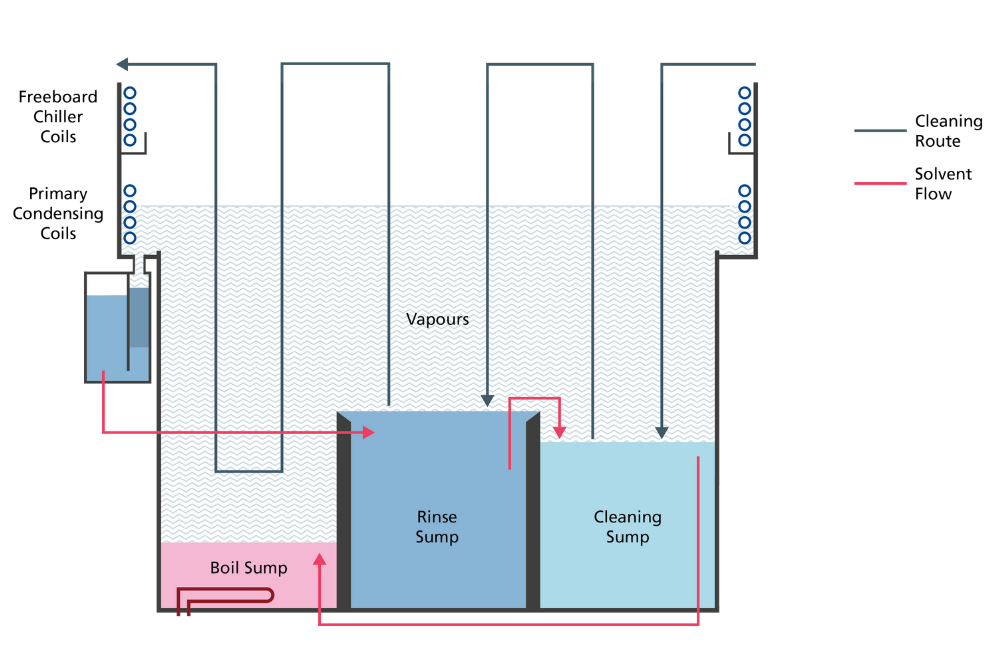
Fluorinated Solvents vs Aqueous Cleaning
It is vital, across many industries such as in aerospace and in the production of medical devices and equipment, that parts and components are cleaned and degreased prior to being assembled and shipped. While there are many cleaning solutions available on the market, it is worth noting that regulations for the chemicals used in these cleaning processes are becoming more and more stringent. For this reason, manufacturers are looking to more environmentally sustainable cleaning solutions such as fluorinated solvents or aqueous cleaning.
Both fluorinated cleaning solvents and aqueous cleaning may help manufacturers in reducing the use of unfavourable chemicals, whilst at the same time still maintaining effective and efficient cleaning. However, each cleaning method offers different advantages and disadvantages which must be considered carefully before selecting the best method for your facility.
What is Aqueous Cleaning?
Aqueous cleaning is carried out with equipment using water as the primary solvent. However, as water alone would not usually be enough to remove contamination, additives would need to be added to the water. Detergents, emulsifiers, inhibitors, pH buffers, and several other additives may be used in combination with heat and agitation to remove contaminants from the parts.
Depending on the type of substrate and contaminants which are being removed, the water may also need to be further treated to become more acidic or basic in order to work effectively. Acidic aqueous solutions are more effective at removing contaminants such as scaling, rust or oxides from metal. Alternatively, alkaline aqueous solutions work better to remove salts, oxides, organic soils, metal chips and grease. Furthermore, alkaline aqueous solutions can be used in a wider range of temperatures than acidic solutions.
Soaking in water, even water with added chemicals, is not typically effective for removing contaminants on high-value parts and aqueous cleaning systems usually also need to use heat, agitation or a pressure spray to effectively clean intricate parts or to eliminate hard-to-remove contaminants.
What is Solvent Cleaning?
Solvent cleaning is the process of cleaning parts using equipment, usually vapour degreasers, which use solvents as their primary solvent. Depending on the type of contamination, different fluorinated solvents, or fluorinated solvent blends, can be selected to remove contaminants of any kind. In contrast to aqueous cleaning, no additives are needed in conjunction with the solvent. During cleaning, contaminated parts are submerged in a cleaning solvent so that contaminants will dissolve to clean the surface of the parts The parts are then rinsed in the vapour of the solvent and subsequently dried. Differently to aqueous cleaning, the cleaning solvent in a vapour degreaser will not wear out. All vapours will condensate within the equipment, be cleaned and then will be reused in the cleaning process once more.

Vapour Degreaser
What are Fluorinated Cleaning Solvents?
Fluorinated cleaning solvents, or fluorosolvents, are high-performance chemicals used for cleaning dirt, oil, fingerprints, solder paste residue, electronics flux and other contaminants from high-value parts and components. Fluorosolvents are regarded as being safer for the environment due to having the following factors:
- No flash point
- No ozone depletion potential (ODP)
- Low global warming potential (LGWP)
- Low surface tension
Due to their low surface tension, fluorosolvents are better able to penetrate the surface of the contaminant while still being gentle on the substrate’s surface. Substrates including metals, plastics, polyurethanes and fluoroelastomers can be cleaned effectively using fluorinated cleaning solvents.
Cost Savings with Fluorinated Cleaning Solvents
Although fluorosolvents may have a higher cost per kilogram, in most cases the total cost of the cleaning process will significantly lower Aqueous equipment is large, expensive and may require a significant reconfiguration of space for installation. Fluorosolvents use a vapor degreaser, which takes up less space and requires less energy due to their shorter cleaning and drying cycles at lower temperatures. Aqueous systems do not dry parts on their own and require post-processes like infrared drying, which consume additional energy and manpower.
They are also known to leave water spots, which will require the use of deionization or reverse osmosis processes on your water to avoid them. Fluorosolvents do not leave spots or residue and is therefore doesn’t require additional processes prior, during, or after the cleaning step.With aqueous cleaning, heating water is absolutely critical to ensure that parts and components are fully cleaned. While fluorosolvents also require heat, their boiling point is significantly lower than water, requiring less energy usage and time. Aqueous systems must also be carefully monitored during the cleaning cycle to ensure that the water level, pH and soap concentration stay at the correct levels. Fluorosolvents are exceptionally stable and can be used over and over again, giving them a lower cost per use. Aqueous cleaners, on the other hand, come with additional costs to reclaim and recycle water or to manage waste oil.
AGC’s Fluorinated Solvents
Our fluorinated solvent range, manufactured by AGC Inc. in Japan, has been designed to address environmental problems such as ozone depletion and global warming. AGC offers non-flammable and safer solvents as well as solvent-based blends, which are used for the degreasing of metal products, precision cleaning and defluxing of electronic circuitry. Other applications include carrier for silicone and fluorinated lubricants, heat transfer fluid and drying. The full product range consists of pure solvents and solvents blends, marketed under the brand names ASAHIKLIN™ and AMOLEA™.
For more information contact our team today.

 AGC Chemicals Europe
AGC Chemicals Europe
